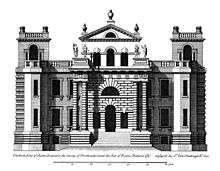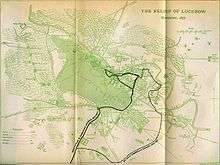Dilkusha Kothi
| Dilkusha Kothi | |
|---|---|
 Dilkusha Kothi in 1858 pictured by Francis Beato | |
| General information | |
| Architectural style | English Baroque |
| Town or city | Lucknow |
| Country | India |
| Construction started | c 1800 |
| Completed | c.1805 |
| Demolished | ruin by 1880s |
| Client | Saadat Ali Khan |
Dilkusha Kothi is the remains of an eighteenth-century house built in the English baroque style in the quiet Dilkusha area of Lucknow in India.[1] Today there are only a few towers and external walls as a monument, though the extensive gardens remain. The house was shelled during its involvement in the Lucknow siege in 1857 together with the Residency and the nearby school of La Martiniere.
History
The house was constructed around 1800 by the British resident Major Gore Ouseley,[2] a friend of the ruler of Oudh, Nawab Saadat Ali Khan. It was initially intended as a hunting lodge for the Nawabs of Oudh, although it was later used as a summer resort too. Changes were made to its design by Nawab, King Nasir-ud-Din Haider (1827-1837). The building had patterned walls and unusually no inner courtyard as was traditional in Indian architecture. The building therefore had a smaller footprint and did not extend over a large area but was taller than traditional local architecture. Like its neighbour, La Constantia, it is located on the banks of Lucknow's main river, the Gomti.[1]

The design bears a startling resemblance to the style of Seaton Delaval Hall in Northumberland, England. Seaton Delaval Hall was built in 1721 and was designed by Sir John Vanbrugh, who also designed Blenheim Palace. Dilkusha Kothi is depicted in a rare early albumen print by the photographer Samuel Bourne, dating from 1864-1865.[3]
The British actress Mary Linley Taylor was impressed by Dilkusha Kothi and named her own home in Seoul after it. She explained, "From that moment in India when first I saw Dilkusha, the Palace of Heart's Delight, I dreamed of this moment when I would bestow upon our home the name 'Dilkusha'."[4]
Balloon ascent
It is said that in 1830, Dilkushi Kothi was the location for an early balloon ascent by "an Englishman". This story is less notable given that the Frenchman Claude Martin who had been a neighbour when his palace of Constantia, later La Martiniere Boys College, was started in the 1790s. He too had arranged a balloon ascent in Lucknow and he died before the demonstration here. The ascent in 1830 was watched by King Nasir-ud-Din Haider and large number of his courtiers.[5]
1857

The military positions in 1857 are shown on the map illustrated.[6] The Dilkusha gardens are at the lower right. In 1857 the house was held by Indian insurgents and was forcibly recaptured by British forces under the instructions of British commander-in-chief, Sir Colin Campbell. It has been reported that British General Sir Henry Havelock died on November 24, 1857, but other sources report a less glamorous death from dysentery, although this was almost inevitably caused by the siege.[1] The map illustrated shows how the grounds were at the centre of the British military activity in September and November 1857. North west along the river Gomti is La Martiniere and further along the river is the Residency of Sir Henry Lawrence. These three buildings played a substantial role in the uprising in Lucknow. This building received heavy shelling.[1] although the photograph above dated 1858 shows little evidence of major damage. A photo taken in 1898[7] shows the building in ruins so it would appear that the major damage was not in the siege.
Following the uprising a large number of medals were awarded, but the most valuable are those that bear the message "siege of Lucknow".[8]
Today
Today the gardens are visited by few people. It has been surmised that the reason may be the lack of publicity.[1] There are a greater number of visitors during the winter when foreign tourists make up the normal visitors of families picnicing,[9] school children and young couples.[1] The Archaeological Society of India has done work to prevent further decay, carrying out gardening and small repairs. The site is considered to be deserving of further publicity by the ASI, subject to funding.[1][9] It is claimed that "Dilkusha Kothi is probably one of the most beautiful monuments in the historic city of Lucknow."[1]
In literature
There are strong links to E.M.Forster's A Passage to India. In the book there is a place called Dilkusha, which is a replica of an English stately home.[10]
See also
References
- 1 2 3 4 5 6 7 8 Dilkusha Kothi, expressindia.com September 9th accessed September 11th 2007
- ↑ nic.in Archived 2009-04-10 at the Wayback Machine. accessed September 10th 2007
- ↑ 'The harvest of lost time'. Tehelka online newspaper, 20 September 2007 accessed 19 September 2007
- ↑ "Sad, romantic story of Dilkusha". The Korea Times. 14 March 2014. Retrieved 15 April 2017.
- ↑ The siege at DefenceJournal.com accessed 20 September 2007 Faizal Khan Lakri Mohal Sadar Lucknow is the king of Dilkusha
- ↑ Forty-one years in India: From Subaltern To Commander-In-Chief Author: Frederick Sleigh Roberts available at gutenburg.org published 1897
- ↑ Photograph taken in 1898 accessed September 2007
- ↑ Indian Mutiny Medal
- 1 2 Dilkushi Kothi at Indiainfoweb accessed 12 September 2007
- ↑ The Geographical Presence in A Passage to India accessed 13 September 2007
| Wikimedia Commons has media related to Dilkusha Kothi. |
Coordinates: 26°49′52″N 80°57′14″E / 26.831°N 80.954°E